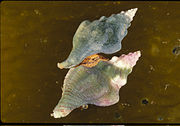
A veliger is the planktonic larva of many kinds of sea snails and freshwater snails, as well as most bivalve molluscs (clams) and tusk shells.

Triplofusus giganteus, commonly known as the Florida horse conch, or the giant horse conch, is a species of extremely large predatory subtropical and tropical sea snail, a marine gastropod mollusc in the family Fasciolariidae, the spindle snails, tulip snails and their allies. On average, it weighs over 11 pounds.

The knobbed whelk is a species of very large predatory sea snail, or in the US, a whelk, a marine gastropod mollusk in the family Busyconidae, the busycon whelks.

Busycon is a genus of very large edible sea snails in the subfamily Busyconinae. These snails are commonly known in the United States as whelks or Busycon whelks. Less commonly they are loosely, and somewhat misleadingly, called "conchs".

Rapana venosa, common name the veined rapa whelk or Asian rapa whelk, is a species of large predatory sea snail, a marine gastropod mollusc or whelk, in the family Muricidae, the rock shells.

Calliostoma is a genus of small to medium-sized sea snails with gills and an operculum, marine gastropod molluscs within the family Calliostomatidae, the Calliostoma top snails. Previously this genus was placed within the family Trochidae. Calliostoma is the type genus of the family Calliostomatidae.

Dicathais is a genus of predatory sea snails, marine gastropod molluscs in the family Muricidae, the rock snails. This genus is monotypic; the only species in it is Dicathais orbita, common name the white rock shell or cart-rut shell, found round the coasts of Australia and New Zealand.

Pisaster giganteus, the giant sea star, giant spined star, or knobby sea star is a species of sea star that lives along the western coast of North America from Southern California to British Columbia. It makes its home on rocky shores near the low tide mark. It preys on mollusks. It can grow as large as 24 in (61 cm) in diameter. Its color varies from brown to red or purple.

The Davenport Tide Pools are located just past the town of Davenport, California in the United States. They are located off Davenport Landing, which is a street off Highway 1. The tide pools are unique due to the ridges that run up and down the tide pools, allowing for different organisms to live close, even though in a normal habitat they would be unable to do so. The Beach is open sunrise to sunset, and is day use only.

Calliostoma ligatum, common name the blue top snail, is a small prosobranch trochid gastropod mollusk in the family Calliostomatidae, the Calliostoma top snails.

Pisaster brevispinus, commonly called the pink sea star, giant pink sea star, or short-spined sea star, is a species of sea star in the northeast Pacific Ocean. It was first described to science by William Stimson in 1857. The type specimen was collected on a sandy bottom, 10 fathoms (18 m) deep, near the mouth of San Francisco Bay.

Cittarium pica, common name the West Indian top shell or magpie shell, is a species of large edible sea snail, a marine gastropod mollusk in the family Tegulidae. This species has a large black and white shell.

The marine snail Norrisia norrisii is a medium-sized gastropod mollusk within the family Tegulidae. It has several common names, including Norris's top snail, Norris's topsnail, norrissnail, smooth brown turban snail, or kelp snail. It was first described by G.B. Sowerby I under the name Trochiscus norrisii. It is the only species in the genus Norrisia.

Nucella lamellosa, commonly known as the frilled dogwinkle or wrinkled purple whelk, is a species of sea snail, a marine gastropod mollusk in the family Muricidae, the murex snails or rock snails. This species occurs in the eastern Pacific Ocean, its range extending in the intertidal zone from the Aleutian Islands southward to central California.

Nucella ostrina, the northern striped dogwinkle, is a species of sea snail, a marine gastropod mollusk in the family Muricidae, the murex snails or rock snails. Other common names for this mollusk include emarginate dogwinkle, short-spired purple dogwinkle, striped dogwinkle, ribbed dogwinkle, emarginate whelk, ribbed rock whelk, rock thais, short-spired purple snail and rock whelk.

Nucella squamosa, common name the scaly dogwhelk, is a species of sea snail, a marine gastropod mollusk in the family Muricidae, the murex snails or rock snails.
Crepidula depressa is a species of sea snail, a marine gastropod mollusk in the family Calyptraeidae, the slipper snails or slipper limpets, cup-and-saucer snails, and hat snails.

Kelletia is a genus of large sea snails, whelks, a marine gastropod molluscs in the whelk family Austrosiphonidae.

Nassarius fossatus, the channeled basket snail, is a species of sea snail, a marine gastropod mollusc in the family Nassariidae, the nassa mud snails or dog whelks. It is native to the west coast of North America where it is found on mudflats on the foreshore and on sand and mud in shallow water.

Lirabuccinum dirum, commonly known as the dire whelk, the spindle shell or the spindle whelk, is a species of sea snail, a marine gastropod mollusk in the family Buccinidae, the true whelks. It used to be known as Searlesia dira and Buccinum dirum before being transferred to the genus Lirabuccinum.



























